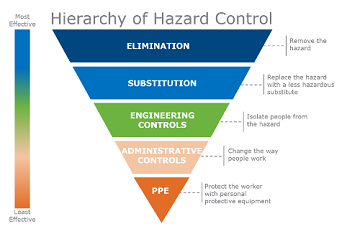- Home
- Loss Control
- Loss Control Insights
- Five Mistakes to Avoid When Using the Hierarchy of Hazard Control
One of the tools EMC safety engineers use to help minimize or eliminate worker exposure to hazards is the hierarchy of hazard control. This simple tool allows organizations to select the control most appropriate to address hazards identified in the workplace. Like most tools, the hierarchy of hazard control works best when it is used correctly.
Being Reactive Rather Than Proactive
Companies often reach for the hierarchy of hazard control following an accident or loss. However, proper use of the tool can reduce the likelihood of those losses. Checklists and proactive audits of a worksite can identify potential hazards, which are best controlled by the appropriate action identified in the hierarchy before an accident occurs.
Starting at the Bottom of the Hierarchy
When workplace hazards are identified, organizations tend to look for an easy solution, such as personal protective equipment (PPE). As illustrated in the chart above, this is the least effective control in the hierarchy. While PPE may be appropriate for some hazards, other control techniques such as elimination, substitution, engineering or administrative controls should also be investigated.
Always Using the Cheap Fix
The basic concept behind the hierarchy is that the control methods at the top are typically more effective than those at the bottom. PPE and some administrative controls may be less expensive solutions, but elimination, substitution and engineering controls can have a long-term impact on preventing common injuries and accidents.
Applying a Control and Forgetting About It
Don’t assume that the control you selected was the correct one for the hazard. Always complete the risk management process by monitoring the control and revising it as needed. If the hazard still exists after implementing one control, consult the hierarchy of hazard control for other possible solutions.
Too Much Emphasis on Training
Administrative controls like safety training are important, but they are no substitute for elimination, substitution or engineering controls. Remember, training does not eliminate the hazard or reduce the worker’s exposure to the hazard. Always consider the controls at the top of the hierarchy first.
If you consistently use this valuable tool correctly, you are likely to create a safe and healthy workplace for all your employees. If you need additional assistance with the hierarchy of hazard control, contact your agent or local EMC loss control representative.Get in touch
Need help? We’re here for you! Whether you have questions or need personalized assistance, your local office is ready to support you.
Loss Control Insights
Stay informed with the latest news and receive actionable safety tips, all carefully curated by our team of experts.
